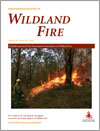International Journal of Wildland Fire
Volume 25
Number 10 2016
We used the FARSITE fire spread simulator to predict the spread of a set of wildfires that occurred in southern Europe. We statistically evaluated the accuracy of FARSITE in predicting the actual fires. We observed a positive effect of the use of customised fuel models vs standard models on simulation accuracy.
Wildfire forecasting tools are needed to improve firefighting operations. An inverse modelling-based system is developed in this paper to predict short-term fire dynamics. The system assimilates airborne infrared images to improve the forward model’s performance. The algorithm is successfully tested with real-scale shrubland fire experiments.
We investigated the main drivers of crown fire by analysing GIS and remote sensing data for 23 bushfires from New South Wales dry forests. Our findings suggest that the influence on crown fire likelihood of weather, fuel levels and slope are not adequately incorporated into current fire behaviour models and fuel management strategies.
An online site provides tools and datasets for the rapid integration of remote sensing observations of burn severity into spatial- and process-based models to aid decision-making activities related to post-fire risk assessment and rehabilitation.
We calculated occurrence rates of 50 bird species in a mixed-conifer forest for 10 years following fire and found that most species (60%) were more abundant in burned than unburned forest, but the positive response to fire was often apparent only under a specific combination of fire severity and time-since-fire parameters.
We investigated the utility of using shrub growth-ring measurements to estimate annual biomass accumulation in a stand of southern California chaparral from 4 to 11 years after burning. The pattern of biomass accumulation tracked closely with precipitation.
This paper explores acceptability of prescribed burning, livestock grazing and mechanical thinning used to reduce wildland fire risk to life and property, in an Australian context. All were considered acceptable by most survey respondents. Acceptability was associated with social trust, knowledge of fuel management and feeling vulnerable to wildland fire.
Traditional fire management has been used in African landscapes but there is uncertainty in our understanding of its impact on soil carbon and nitrogen. Our study shows that traditional fire management did not affect forest floor or mineral soil carbon and nitrogen pools in a montane forest in southern Ethiopia.




